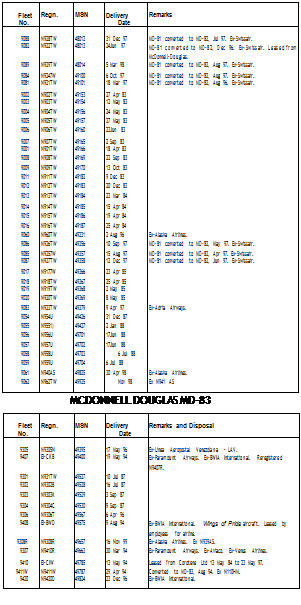Stretched to the Limit
MCDONNELL MD-82
 |
||||||||||||||||||||||||||||||||||||||||||||||||||||||||||||||||||||||||||||||||||||||||||||||||||||||||||||||||||||||||||||||||||||||||||||||||||||||||||||||||||||||||||||||||||||||||||||||||||||||||||||||||||||||||||||||||||||||||||||||||||||||||||||||||||||||||||||
|
|
|||||||||||||||||||||||||||||||||||||||||||||||||||||||||||||||||||||||||||||||||||||||||||||||||||||||||||||||||||||||||||||||||||||||||||||||||||||||||||||||||||||||||||||||||||||||||||||||||||||||||||||||||||||||||||||||||||||||||||||||||||||||||||||||||||||||||||
|
||||||||||||||||||||||||||||||||||||||||||||||||||||||||||||||||||||||||||||||||||||||||||||||||||||||||||||||||||||||||||||||||||||||||||||||||||||||||||||||||||||||||||||||||||||||||||||||||||||||||||||||||||||||||||||||||||||||||||||||||||||||||||||||||||||||||||||

 |

Delivery scheme for the first DC-9-80s sported a bare-metal upper vertical fin. This was later painted all white to conform to other TWA aircraft.

An Old Tradition
Back in the 1930s, the Douglas company had shown considerable enterprise in developing its original twin piston-engined world-beater, the legendary DC-3. Later, in the 1940s and 1950s, it did the same with the four-engined DC-4/6/7 series; and continued the tradition of “stretching” the fuselage with the DC-8 jets. It did even better with the short-haul twin-jet, the DC-9, which went into service with Delta in 1965 (see page 77). This started off as an airliner with as few as 65 seats (or up to 109 in all-economy layout); but with progressive improvements, especially in more engine power, its fuselage was stretched as never before. The Series 10’s 104-foot length was increased by 15 feet for the Series 30, and further extensions, permitting extra rows of seats, were made with the Series 40 and 50.
The Dash 80
The ultimate challenge to the Douglas engineers came when their project office proposed a further 15-foot stretch of the Series 50. This became the Series 80, or the Super 80, and following the inevitable change of nomenclature resulting from the McDonnell Douglas merger in the late 1960s, this highly successful airliner was known as the MD-80. Remarkably, its additional length, devoted entirely to the passenger cabin, permitted a seating capacity of 172, twice as many as in the first DC-9-10. The first airline to put this version, a DC-9-81, into service was Swissair, on 5 October 1980. T. W.A. took delivery of its first MD-82 in April 1983, and liked it so much that it kept buying more of both the 82 and the 83 variants. It even bought some of Swissair’s 81s and converted them to 82s.
Last of the Line
Deliveries of this fine airliner, with its unmistakable silhouette in the sky, continued until the end of 1999. The last one went to St. Louis on 28 December of that year. It had taken off from the factory where the airplane was first conceived and developed, at Long Beach, California; and although T. W.A. had abandoned its practice of naming its aircraft at the end of the piston-engined propeller era, this was a special case. T. W.A. fleet number 9654, manufacturer’s serial number (msn) 53634, registration number N984TW, was proudly named the Spirit of Long Beach.
Engines Pratt & Whitney JT8D-217C (20,000 lb) x 2 Length 148 feet
MGT0W 140,0001b Span 108 feet
Range 1,500 miles Height 30 feet
|
|











